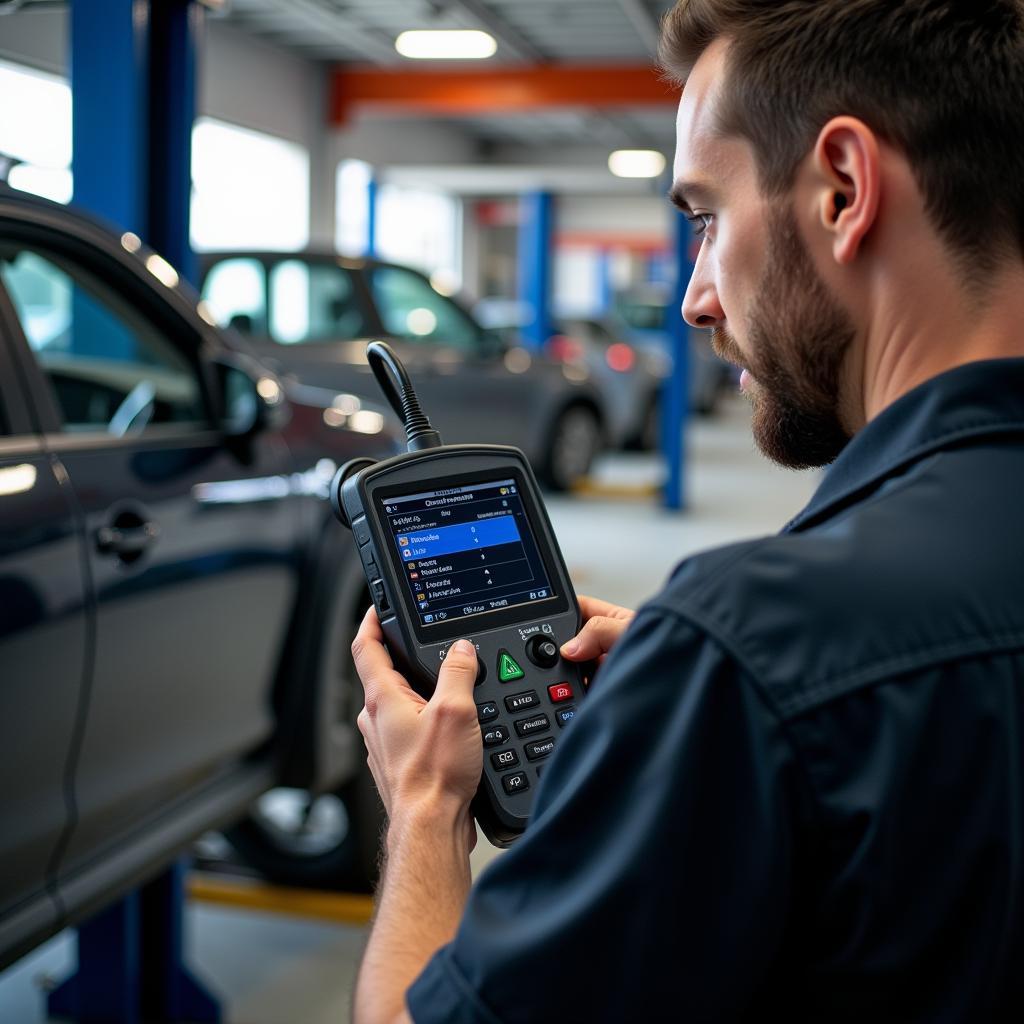In today’s tech-driven world, even car repairs are getting a digital makeover. A Universal Car Diagnostic Tool is no longer a luxury for professional mechanics; it’s becoming an essential tool for car owners who want to understand and address their vehicles’ needs proactively.
 Universal Car Diagnostic Tool Connected to Car Dashboard
Universal Car Diagnostic Tool Connected to Car Dashboard
What is a Universal Car Diagnostic Tool?
A universal car diagnostic tool, often referred to as an OBD2 scanner, is a device that connects to your car’s onboard computer system through the OBD-II port. This port, typically located under the dashboard on the driver’s side, acts as a communication gateway to access your car’s health data.
These tools read and interpret diagnostic trouble codes (DTCs) generated by your car’s computer, which indicate potential issues with various systems, including the engine, transmission, airbags, and emissions control.
 Mechanic Using a Diagnostic Tool on a Car in the Garage
Mechanic Using a Diagnostic Tool on a Car in the Garage
Why Do You Need a Universal Car Diagnostic Tool?
Owning a universal car diagnostic tool can be incredibly beneficial for several reasons:
- Early Problem Detection: Identifying car troubles early on can save you from costly repairs down the line.
- Cost Savings: By understanding the DTCs, you can avoid unnecessary trips to the mechanic for minor issues or get a head start on researching repair options.
- Improved Communication with Mechanics: Walking into a mechanic’s shop armed with knowledge about potential problems empowers you to have more informed conversations and potentially avoid unnecessary services.
- DIY Repairs: For the mechanically inclined, these tools can empower you to perform basic repairs and maintenance yourself.
- Enhanced Car Knowledge: Understanding your car’s inner workings through the data provided can help you become a more informed and proactive car owner.
Choosing the Right Universal Car Diagnostic Tool
With a plethora of options available, selecting the right universal car diagnostic tool can seem overwhelming. Here’s what to consider:
- Compatibility: Ensure the tool is compatible with your car’s make, model, and year. Most modern cars (post-1996) are equipped with the OBD-II standard.
- Functionality: Determine the features you need. Some tools offer basic code reading, while others provide live data streaming, graphing capabilities, and advanced diagnostic functions.
- User Interface: Opt for a tool with an intuitive and easy-to-navigate interface. Consider factors like screen size, button layout, and menu structure.
- Price: Prices can range significantly based on functionality. Set a budget and choose a tool that offers the best value for your needs.
- Reviews and Ratings: Research online reviews and compare ratings to gauge user experiences and product reliability.
Key Features to Look for
While specific features may vary, here are some key functionalities to prioritize:
- Reading and Clearing DTCs: The fundamental function of any diagnostic tool is to read and clear DTCs.
- Live Data Streaming: This feature allows you to monitor real-time data from various sensors, giving you insights into your car’s performance.
- Graphing: Visualizing data trends through graphs can help identify intermittent issues and monitor sensor performance over time.
- ABS and Airbag Diagnostics: Advanced tools may offer diagnostics for critical safety systems like ABS and airbags.
- ECU Programming: Some high-end tools support ECU (Engine Control Unit) programming, allowing for advanced customization and tuning.
smart car fault diagnostics near me
Making the Most of Your Diagnostic Tool
Owning a universal car diagnostic tool is just the first step. To truly benefit, consider these tips:
- Familiarize Yourself with the Tool: Spend time reading the user manual and exploring the different features and menus.
- Start with Basic Diagnostics: Begin by performing a basic scan to check for any stored DTCs.
- Research DTC Meanings: Don’t panic when you see a code. Use online resources or the tool’s built-in database to understand what each code signifies.
- Utilize Online Forums and Communities: Connect with other car enthusiasts and experts online to seek advice, share experiences, and learn from their knowledge.
- Stay Updated: Manufacturers frequently release software updates for their diagnostic tools. Regularly update your tool to ensure optimal performance and access to the latest features.
Conclusion
A universal car diagnostic tool is no longer a luxury reserved for professionals. It’s an empowering tool for car owners who want to take control of their vehicle’s maintenance, understand its needs, and potentially save on repair costs. By understanding the key features, choosing the right tool, and utilizing its capabilities effectively, you can become a more informed and proactive car owner.
FAQs
1. Can I use a universal car diagnostic tool on any car?
While most modern cars use the OBD-II standard, compatibility may vary depending on the make, model, and year of your car. It’s crucial to check the tool’s compatibility specifications before purchasing.
2. Will using a universal car diagnostic tool void my car’s warranty?
No, using a diagnostic tool to read DTCs will not void your car’s warranty. However, attempting repairs or modifications based solely on the tool’s readings may affect your warranty coverage.
3. Can a universal car diagnostic tool fix my car problems?
A diagnostic tool primarily helps identify potential issues but doesn’t inherently fix them. It provides valuable information to guide you toward the appropriate repair solutions.
car diagnostics in st helens town centre
4. Are universal car diagnostic tools difficult to use?
Many modern diagnostic tools are designed with user-friendliness in mind. However, the complexity can vary depending on the tool’s features. Start with the basic functions and gradually explore more advanced capabilities.

Leave a Reply